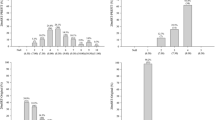Abstract
There is still considerable debate and some confusion as to the most appropriate method of scaling or normalizing maximum oxygen uptake (V̇O2max) for differences in body mass (m) in both adults and children. Previous studies on adult populations have demonstrated that although the traditional ratio standard V̇O2max (ml kg−1 min−1) fails to render V̇O2max independent of body mass, the ratio standard is still the best predictor of running performance. However, no such evidence exists in children. Hence, the purpose of the present study was to investigate whether the ratio standard is still the most appropriate method of normalising V̇O2max to predict 1-mile run speed in a group of 12-year-old children (n=36). Using a power function model and log-linear regression, the best predictor of 1-mile run speed was given by: speed (m s−1)=55.1V̇O2max 0.986 m −0.96. With both the V̇O2max and body mass exponents being close to unity but with opposite signs, the model suggest the best predictor of 1-mile run speed is almost exactly the traditional ratio standard recorded in the units (ml kg−1 min−1). Clearly, reporting the traditional ratio standard V̇O2max, recorded in the units (ml kg−1 min−1), still has an important place in publishing the results of studies investigating cardiovascular fitness of both children and adults.


Similar content being viewed by others
References
Astrand P-O, Rodahl K (1986) Textbook of work physiology, 3rd edn. McGraw-Hill
Heusner AA (1987) What does the power function reveal about structure and function in animals of different size? Annu Rev Physiol 49:121–133
Jolicoeur P, Heusner AA (1971) The allometry equation in the analysis of the standard oxygen consumption and body weight of the white rat. Biometrics 27:841–855
Kleiber M (1932) Body size and metabolism. Hilgarida 6:315–353
Kleiber M (1947) Body size and metabolic rate. Physiol Rev 27:511–541
McMahon T (1973) Size and shape in biology. Elastic criteria impose limits on biological proportions, and consequently on metabolic rates. Science 174:1201–1204
Nevill AM (1997) The appropriate use of scaling techniques in exercise physiology. Pediatr Exerc Sci 9:295–298
Nevill AM, Holder RL (1994) Modelling maximum oxygen uptake—a case study in non-linear regression model formulation and comparison. J R Stat Soc Ser C 43:653–666
Nevill AM, Ramsbottom R, Williams C (1992) Scaling physiological measurements for individuals of different body size. Eur J Appl Physiol 65:110–117
Nevill AM, Brown D, Godfrey R, Johnson PL, Romer L, Stewart AD, Winter EM (2003) Modeling maximum oxygen uptake of elite endurance athletes. Med Sci Sports Exerc 35:488–494
Nevill AM, Stewart AD, Olds T, Holder RL (2004) Are adult physiques geometrically similar? The dangers of allometric scaling using body mass power laws. Am J Phys Anthropol 124 (in press)
Prampero PE di (2003) Factors limiting maximal performance in humans. Eur J Appl Physiol 90:420–429
Rowland T, Kline G, Goff D, Martel L, Ferrone L (1999) One-mile run performance and cardiovascular fitness in children. Arch Pediatr Adolesc Med 153:845–849
Schmidt-Nielsen K (1984) Scaling: why is animal size so important? Cambridge University Press, Cambridge
Welsman JR, Armstrong N, Nevill AM, Winter EM, Kirby BJ (1996) Scaling peak VO2 for differences in body size. Med Sci Sports Exerc 28:259–265
Weibel ER (2002) The pitfalls of power laws. Nature 417:131–132
Author information
Authors and Affiliations
Corresponding author
Rights and permissions
About this article
Cite this article
Nevill, A., Rowland, T., Goff, D. et al. Scaling or normalising maximum oxygen uptake to predict 1-mile run time in boys. Eur J Appl Physiol 92, 285–288 (2004). https://doi.org/10.1007/s00421-004-1071-z
Accepted:
Published:
Issue Date:
DOI: https://doi.org/10.1007/s00421-004-1071-z




